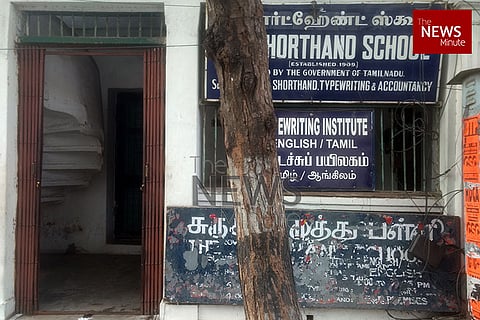

At 5.50 am every day, B Padmanabhan ascends the familiar, spiral staircase leading to his 109-year-old shorthand and typewriting institute, The Shorthand School.
Nestled between the buildings that have sprung up on Mylapore’s Kutchery Road, the school is easy to miss. The board, with its paint peeling, is almost hidden by the branches of the huge neem tree outside it.
Students start walking in as early as 6.00 am and the familiar but forgotten ‘tak-tak-tak-clang-zip’ of typewriters fills the room.
“The institute was founded in 1909 by my late grandfather P Srikandaiyer with 20 typewriters,” beams Padmanabhan. “While the first one in Madras city was in Chintadripet, ours was the second in the entire city!”
In 1933, the institute shifted to its present premises on Kutchery Road and has been functioning from here ever since.
The ’70s and ’80s were a glorious period for typewriting institutes in the country when applicants to all government jobs had to have typewriting certificates. And Mylapore alone had 33 such institutes to boast of.
“Initially, when the institute was started, only Anglo-Indians came here to learn typewriting and shorthand. This was back when my grandfather, who used to work as a Commerce teacher at Adyar’s St Patrick’s School, used to teach,” he says.
“During World War I we had to close for about three years from 1914 to 1917. It was mainly because people did not stay in the city then. After the war, however, we began functioning again,” says Padmanabhan.
Mylapore now only has about six typewriting schools, and Shorthand School is the oldest of the lot.
In 1944, Padmanabhan’s father S Balasubramanian began teaching at the institute.
“My father was 21-years-old when he obtained his certificates and joined my grandfather in teaching. In 1969, I took over from the two of them,” Padmanabhan tells us.
Following decline in its popularity, the institute stopped teaching shorthand in 2008. But there still is a base that requires this knowledge.
“Certain Central Government jobs might require this skill, and advocates and legal professionals still come to us to learn this,” he says.
In an age when children learn how to type on their own very early thanks to ubiquitous smartphones and tablets, what role does a typewriting institute play?
“How can people operate the computer efficiently without learning how to type? They’ll only use two fingers which is highly inefficient,” exclaims Padmanabhan.
He adds, “In their first level of exam, they’ll have to type 300 words in under ten minutes. And gaining that kind of speed will take more than five months.”
His words ring true. The institute has several youngsters walking through its doors to learn typing.
Sujitha, who is still in school, says the skill will be of use to her. “I joined the classes last year when I was in Class 11, but I did not get through my first attempt in the level-one exam. I hope to finish level one before I finish school,” she says.
Haripreetha, who is currently studying B Com at SIET College, is very hopeful that the typewriting certificate will help realise her dream of working in a bank or perhaps join a corporate.
With 110 students enrolled in the school, Padmanabhan, its only teacher, holds 12 sessions a day for Rs 350 per month per student.
And what are his future plans? “There’s a decline in interest when it comes to learning typewriting,” he shrugs. “So what is the point?”